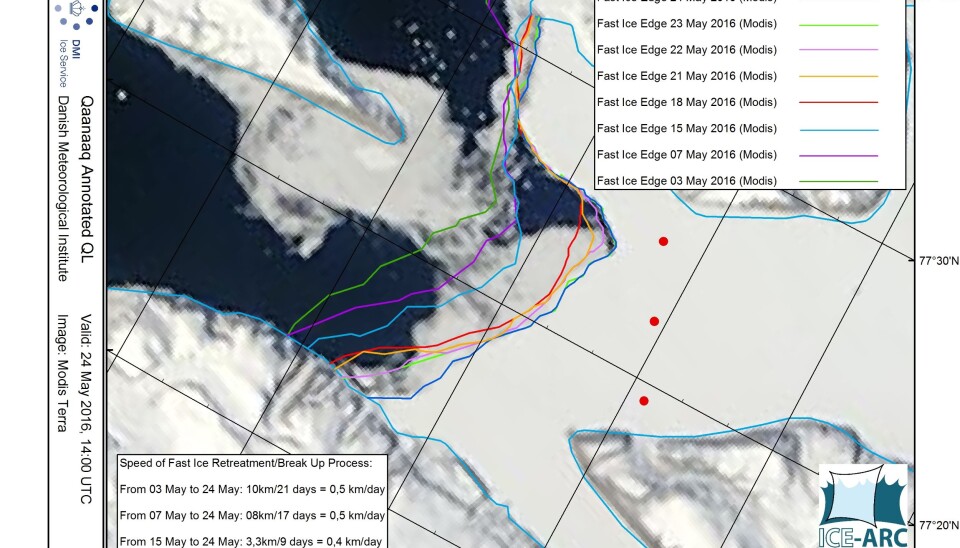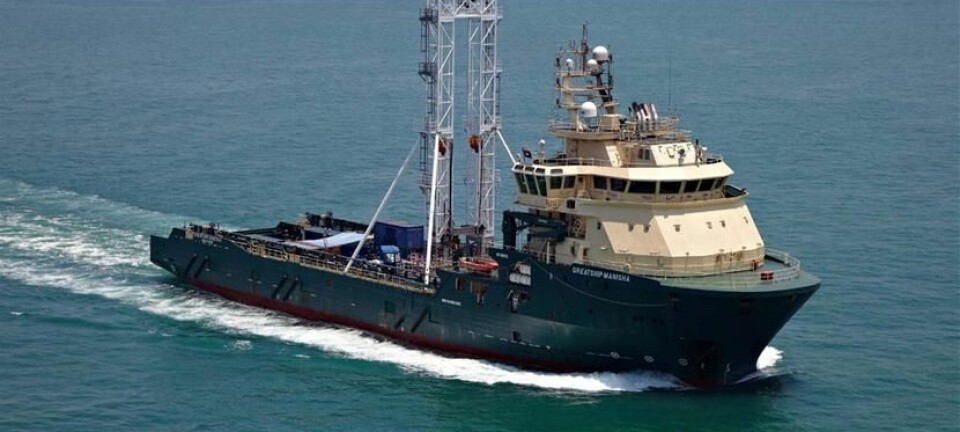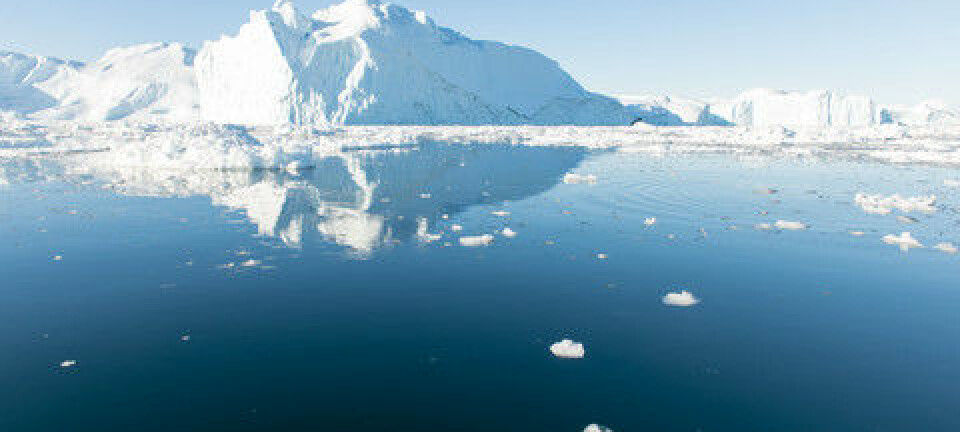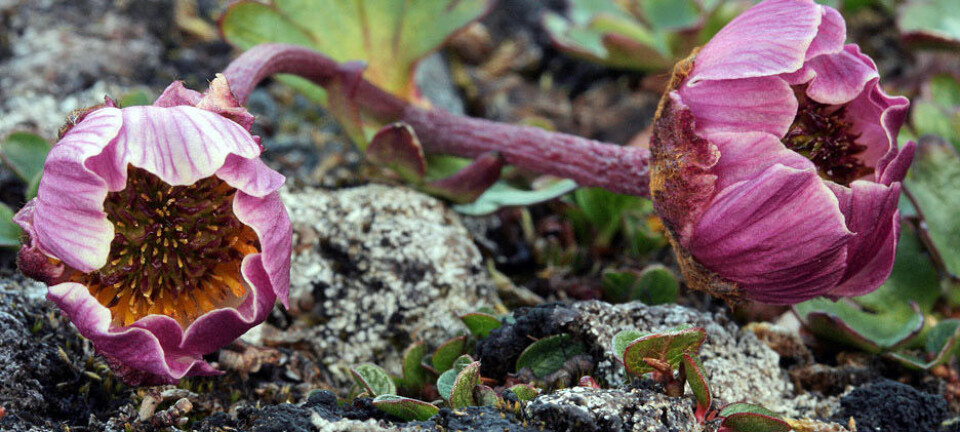
Arctic sea ice at a record low
Sea ice in the Arctic Ocean is at a record low for this time of year, as monthly temperature records continue to soar around the world.
Video: Sea ice in the Arctic remains at a record low this year, and the melt season has only just begun. (Video: Science Nordic / Polarportal.dk)
The extent of sea ice in the Arctic Ocean is already at a record low for this time of year and scientists are concerned as to how much ice will survive the 2016 melt season.
“This is the lowest ever extent of sea ice for this time of year since 1978, when [satellite observations began],” says Rasmus Tonboe, from the Danish Meteorological Institute (DMI), who has been monitoring the progression of sea ice in the Arctic Ocean.
The extent of summer sea ice has been consistently low since 2007 and especially so in the last four years. Tonboe and colleagues are keeping a close eye on the next few weeks, which will give them a better indication of how the rest of the melt season will progress throughout the Arctic.
The worrying trend follows the warmest April on record, in what some climate scientists now warn is shaping up to be the warmest year on record.
Spiralling global temperatures from 1850-2016 (full animation) https://t.co/YETC5HkmTr pic.twitter.com/Ypci717AHq
— Ed Hawkins (@ed_hawkins) May 9, 2016
Early start to melt season and ice breakup
An unusually early breakup of sea ice has caused problems elsewhere in the Arctic. This week, DMI scientists scrambled to recover a weather station situated on the ice in Inglefield Bredning fjord, near Qaanaaq, northwest Greenland.
The fjord ice was retreating by half a kilometre a day, which is exceptional for the time of year.
“We’ve retrieved the equipment now, with the help of the local hunters, who help DMI with logistics on the ice up there,” says Martin Nissen, an ice advisor from DMI.
“The ice [front] was about 3.5 km away from the weather stations and it may only have taken one big wind event to break off this entire part of the sea ice,” he says.
And this early breakup of sea ice is not unique to Qaanaaq.
“This region has been warming gradually over the last couple of decades and it has also been a fairly warm spring. This is one of the earlier breakups that we’ve seen in the area, but we expect other areas to follow,” says Nissen.
“In general, Arctic ice is breaking up faster this year than any time before, and this is just another example,” says Tonboe.
Thin ice in a spiral of decline
Sea ice has been declining in the Arctic ever since scientists started monitoring it with satellites in 1978. But the decline has not been a gradual predictable trend from year to year. The rapid decline really got going after the summer of 2007.
“From 2007 the sea ice extent in the Arctic and especially in the summer was at a record low, and from then on it never really recovered,” says Tonboe.
Less and less thick ice now survives the summer melt season. This leaves behind thin ice deposits, so-called ‘first year ice’ that starts to form in autumn and is typically less than two metres thick.
This thin ice is even more vulnerable to summer melt, when the suns radiation is at a maximum and cloud cover is often relatively low.
“When we lose this sea ice, we get a lot of absorption of radiation into the water column, which initiates a feedback loop known as the ice-albedo feedback,” says Tonboe.
Watch this process in action in the video below.
Ice-free Arctic summers by 2100
This switch from thick to thin ice is particularly noticeable in regions such as the Beaufort Sea in the Arctic Ocean, says Tonboe. Here, ocean currents used to keep the ice circulating, allowing it to grow into thick deposits. But this process ended abruptly in 2007 and sea ice has been in decline ever since.
“This is a very important area for the development of thick multi-year ice, which is important for the robustness of sea ice in the Arctic. But now it’s a region of ice melt, and I think that sea ice cover in the Arctic as a whole is heading towards something that looks more like first year ice, which is much more vulnerable to warm summers.”
“Of course, my big concern is that the melt will be so severe that most of the thick ice will disappear from the Arctic Ocean,” says Tonboe.
Scientists predict that the Arctic could be ice-free for up to seven months of the year by the end of this century.
“This means that we will have new conditions--more wind and open water in the arctic,” says oceanographer Mikhail Dobrynin, University of Hamburg, Germany, speaking at a press conference on sea ice decline in the Arctic at the European Geosciences Union General Assembly 2016.
An ice-free Arctic might open up new fishing waters and shipping routes, but it will also be wavier and erode the coastlines of Siberia, Russia, northern Europe, and Canada.
Read more: Greenland melt linked to weird weather in the USA and Europe
Video: Watch how the ice-albedo feedback leads to further ice melt in the Arctic Ocean. (Video: Science Nordic / NASA)









